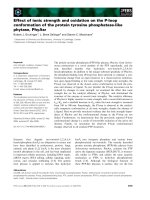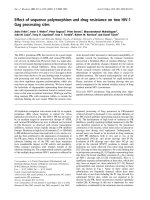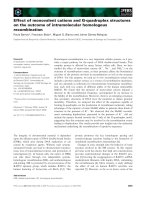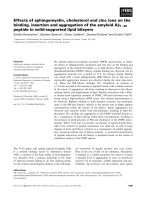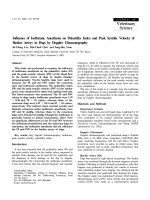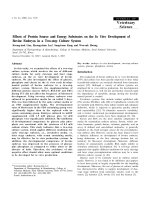Báo cáo khoa học: "Influence of support on intra-abdominal pressure, hepatic kinetics of indocyanine green and extravascular lung water during prone positioning in patients with ARDS: a randomized crossover study" pot
Bạn đang xem bản rút gọn của tài liệu. Xem và tải ngay bản đầy đủ của tài liệu tại đây (257.63 KB, 7 trang )
Open Access
Available online />R251
Vol 9 No 3
Research
Influence of support on intra-abdominal pressure, hepatic kinetics
of indocyanine green and extravascular lung water during prone
positioning in patients with ARDS: a randomized crossover study
Pierre Michelet, Antoine Roch, Marc Gainnier, Jean-Marie Sainty, Jean-Pierre Auffray and
Laurent Papazian
Service de Réanimation Chirurgicale, Hôpitaux Sud, Marseille, France
Corresponding author: Pierre Michelet,
Received: 19 Nov 2004 Revisions requested: 26 Jan 2005 Revisions received: 21 Feb 2005 Accepted: 7 Mar 2005 Published: 31 Mar 2005
Critical Care 2005, 9:R251-R257 (DOI 10.1186/cc3513)
This article is online at: />© 2005 Michelet et al.; licensee BioMed Central Ltd.
This is an Open Access article distributed under the terms of the Creative Commons Attribution License ( />2.0), which permits unrestricted use, distribution, and reproduction in any medium, provided the original work is properly cited.
Abstract
Introduction Prone positioning (PP) on an air-cushioned
mattress is associated with a limited increase in intra-abdominal
pressure (IAP) and an absence of organ dysfunction. The
respective influence of posture by itself and the type of mattress
on these limited modifications during the PP procedure remains
unclear. The aim of this study was to evaluate whether the type
of support modifies IAP, extravascular lung water (EVLW) and
the plasma disappearance rate of indocyanine green (PDR
ICG
)
during PP.
Methods A prospective, randomized, crossover study of 20
patients with acute respiratory distress syndrome (ARDS) was
conducted in a medical intensive care unit in a teaching hospital.
Measurements were made at baseline and repeated after 1 and
6 hours of two randomized periods of 6 hours of PP with one of
two support types: conventional foam mattress or air-cushioned
mattress.
Results After logarithmic transformation of the data, an analysis
of variance (ANOVA) showed that IAP and PDR
ICG
were
significantly influenced by the type of support during PP with an
increase in IAP (P < 0.05 by ANOVA) and a decrease in PDR
ICG
on the foam mattress (P < 0.05 by ANOVA). Conversely, the
measurements of EVLW did not show significant modification
between the two supports whatever the posture. The ratio of the
arterial oxygen tension to the fraction of inspired oxygen
significantly increased in PP (P < 0.0001 by ANOVA) without
any influence of the support.
Conclusion In comparison with a conventional foam mattress,
the use of an air-cushioned mattress limited the increase in IAP
and prevented the decrease in PDR
ICG
related to PP in patients
with ARDS. Conversely, the type of support did not influence
EVLW or oxygenation.
Introduction
Prone positioning (PP) improves arterial oxygenation in 50 to
75% of patients presenting with acute respiratory distress
syndrome (ARDS) [1]. Although this postural treatment is cur-
rently considered simple and safe [1], the restriction of abdom-
inal movements during PP is associated with an increase in
intra-abdominal pressure (IAP) [2-5] with potential adverse
effects on hemodynamic status and splanchnic perfusion [6-
8]. Several studies have evaluated the clinical implications of
this side effect of PP [4,5,9]. They reported significant but lim-
ited increases in IAP without impairment of cardiopulmonary,
renal or hepatosplanchnic functions during short periods of
PP. However, all patients included in these studies were
placed on air-cushioned beds, which might have reduced the
restriction of abdominal movement during PP [4,5,9] com-
pared with a conventional foam mattress. Indeed, the air-cush-
ioned mattress reduced interface pressure to a greater extent
than the foam mattress [10,11]. Moreover, the addition of pil-
lows under the thorax and the pelvis did not produce a
decrease in IAP during the PP procedure with a foam mattress
[12]. Because no direct comparison has been made between
different supports, the respective influences of the type of
ANOVA = analysis of variance; ARDS = acute respiratory distress syndrome; EVLW = extravascular lung water; FiO
2
= fraction of inspired oxygen;
IAP = intra-abdominal pressure; PaO
2
= arterial oxygen tension; PDR
ICG
= plasma disappearance rate of indocyanine green; PEEP = positive end-
expiratory pressure; PP = prone positioning.
Critical Care Vol 9 No 3 Michelet et al.
R252
support and the posture itself on IAP and its related potential
adverse effects remain unclear. Therefore, in the perspective
of standardization, the question of the interest of a special
device before the institution of PP should be clarified [1].
The aim of the present study was to investigate whether the
evolution of IAP, liver function assessed by the plasma disap-
pearance rate of indocyanine green (PDR
ICG
) [5] and extra-
vascular lung water is related to the type of support during PP.
We therefore prospectively compared, in a population of med-
ical-ARDS patients, the effects of an air-cushioned mattress
and a conventional foam mattress during PP.
Methods
Patients
Twenty consecutive patients with ARDS were included and
turned prone in the medical intensive care unit of Sainte Mar-
guerite University Hospital in Marseille, France. Patients were
prospectively included in this study after obtaining written
informed consent from the next of kin. The study design was
approved by the Comité Consultatif de Protection des Person-
nes dans la Recherche Biomédicale of Marseille. ARDS was
defined in accordance with the recommendations of the Amer-
ican–European Consensus Conference [13]. Patients with
unstable cardiovascular function, cerebral injury or unstable
spinal fractures, patients subjected to major abdominal sur-
gery and patients with a history of neuromuscular disease
were excluded.
Sedation, catheters and ventilation
All patients were sedated and paralyzed by the continuous
infusion of sufentanil, midazolam and cisatracurium throughout
the study period and were ventilated with conventional vol-
ume-controlled mechanical ventilation (7200 series or 840,
Mallinckrodt Puritan Bennett, Carlsbad, CA, USA).
Respiratory and hemodynamic status was stable for 12 hours
before inclusion. When patient received vasoactive drugs, the
rate of infusion was kept stable throughout the study. On inclu-
sion into the study, the mean tidal volume was 6.9 ± 1.9 ml/kg,
the mean respiratory rate was 20 ± 4 cycles/min (the respira-
tory rate was adjusted to maintain a constant minute ventilation
throughout the study period) and the positive end-expiratory
pressure was 11.3 ± 2.0 cmH
2
O. The selection of the appro-
priate PEEP level was performed by increasing PEEP in steps
of 2 cmH
2
O. A blood gas analysis was performed after a 30
min period of stabilization of blood oxygen saturation. Finally,
the lower level of PEEP giving the greater improvement of oxy-
genation was chosen. The levels of PEEP, the tidal volume and
a fraction of inspired oxygen (FiO
2
) of 0.8 were maintained
constant throughout the study period.
A pulmonary artery catheter (Baxter Healthcare Corporation,
Irvine, CA, USA) was placed in all patients. It was inserted per-
cutaneously through the right jugular or left subclavian vein
and positioned with the distal port in the pulmonary artery and
the proximal port in the right atrium. For measurements of the
PDR
ICG
and extravascular lung water (EVLW), a 5F catheter
was placed into the left femoral artery, together with a thermis-
tor-tipped fiber-optic catheter (Pulsiocath, 4F, FT, PV-2024-L;
Pulsion Medical System, Munich, Germany) which was
advanced into the descending aorta.
Support surfaces
The control surface was a three-piece molded foam mattress
(APLOT
®
; Asklé, Nîmes, France). The specialist air mattress
was a dynamic alternating cells design, with automatic adjust-
ment for patient weight (ProNimbus
®
; Huntleigh Healthcare,
Luton, UK).
Measurements
Hemodynamic parameters
Routine invasive hemodynamic monitoring included arterial
and pulmonary artery thermodilution catheters. Systemic and
pulmonary arterial pressures, pulmonary artery occlusion pres-
sure and right atrial pressure were measured at end-expiration.
The midaxillary line was taken as the zero reference point in the
supine and prone positions. Cardiac index, venous admixture
and pulmonary vascular resistance were calculated from con-
ventional formulas.
Blood gas analysis
Systemic and pulmonary arterial blood samples were with-
drawn simultaneously within 3 min after the measurement of
cardiac output. Arterial pH, arterial oxygen tension (PaO
2
) and
arterial CO
2
tension were measured with a blood gas analyzer
(278-blood gas system; Ciba Corning, Medfield, MA, USA).
Arterial and mixed venous oxygen saturation (SaO
2
and SvO
2
,
respectively) were measured with a calibrated hemoximeter
(270-CO-oxymeter; Ciba Corning).
Respiratory parameters
The respiratory parameters measured were compliance of the
respiratory system, exhaled tidal volume, peak inspiratory pres-
sure, mean inspiratory pressure, and respiratory rate. Quasi-
static compliance of the total respiratory system was obtained
by dividing the tidal volume by the difference between plateau
pressure and the total PEEP according to the method
described by Gattinoni and colleagues [14].
Thoracic volumes, EVLW and hepatosplanchnic perfusion
measurements
The transpulmonary indicator dilution technique was used to
determine the intrathoracic blood volume, the EVLW and the
PDR
ICG
[15]. PDR
ICG
is derived from the half-life of indocya-
nine green and reflects the percentage of the initial plasma dye
level eliminated by the liver [16]. A thermistor-tipped fiber-
optic catheter placed in the descending aorta detected the
dye and temperature dilution curves. The EVLW and the
PDR
ICG
were automatically calculated by a computer (Pulsion
Available online />R253
Cold Z-021; Pulsion Medical System) from the average of
three measurements [16].
Measurement of IAP
IAP was measured with a transurethral bladder catheter [17].
Normal saline (100 ml) was infused through the urinary cathe-
ter into the bladder. The catheter was then clamped and the
IAP was recorded by a pressure transducer as mean pressure
at end-expiration. Zero was set at the level of the pubis in both
positions.
Protocol
Baseline measurements were performed in the supine position
after 1 hour of steady-state conventional mechanical ventila-
tion. Then the following two periods of PP were randomized: 6
hours of PP on the moulded foam mattress, and 6 hours of PP
on the air-cushioned mattress. A period of 18 h in the supine
position separated the two periods in the prone position. Each
patient was his or her own control. Measurements were
achieved in the supine position, after 1 and 6 hours of PP.
Change in position was performed manually by three nurses
and two staff members. In the prone position, the arms were
laid parallel to the body. Care was taken to avoid eye damage
and any non-physiological movements of the limbs during pos-
ture changes. Whatever type of support was used, no pillow
was used to support regions such as the chest or pelvis.
Measurements were performed before, after 1 hour and after
6 hours of each period of PP.
Statistical analysis
Statistical calculation was performed with the Sigma Stat 3.0
package (SPSS Inc., Chicago, IL, USA). Distribution was
checked. Data were expressed as mean ± SD if the distribu-
tion was normal and as medians and interquartile range if the
distribution was not normal. Significant differences were ana-
lyzed by general factorial analysis of variance (ANOVA) with a
prior logarithmic transformation when required (non-paramet-
ric distribution). For intra-group changes, Tukey's test for mul-
tiple comparisons was applied to compare the variations
between supports and different times of the study. For serum
transaminases and creatinine, a Mann–Whitney U-test was
used to compare the values before and after the protocol.
When a correlation was calculated, Pearson's coefficient of
correlation was used. When distribution was not normal,
Spearman's rank correlation was used.
P < 0.05 was considered significant.
Results
Characteristics of the population are listed in Table 1. On
admission, the mean Simplified Acute Physiologic Score II
(SAPS II) score was 52 ± 12 and the severity of ARDS was
assessed by a lung injury score of more than 2.5 in all patients
(3.1 ± 0.3). The mortality rate for the 20 patients (15 men, 5
women; age 53 ± 12) was 25%. Among the patients enrolled
in the study, six patients received norepinephrine (noradrena-
line) (dose 0.3 ± 0.2 µg/kg per min) and one patient received
epinephrine (adrenaline) (0.4 µg/kg per min) on inclusion. No
modification of the infusion rate of norepinephrine and epine-
phrine and no fluid expansion were undertaken during the
study period.
Effects of prone position and support on IAP,
hepatosplanchnic function and EVLW
A logarithmic transformation of the data led to normally distrib-
uted values of IAP and PDR
ICG
. We therefore performed a
two-way ANOVA that showed an increase in IAP after 1 and 6
hours of PP on a foam mattress in comparison with baseline
values (P < 0.01 by Tukey's test; Fig. 1) whereas it remained
unchanged when patients were positioned on a specialist air
mattress. IAP was higher on a foam mattress after 6 hours of
PP in comparison with a specialist air mattress (P < 0.05 by
Tukey's test; Fig. 1). PDR
ICG
decreased after 1 and 6 hours of
PP on a foam mattress in comparison with baseline values (P
< 0.05 by Tukey's test, Table 2 and Fig. 2) whereas it remained
unchanged when patients were positioned on a specialist air
mattress.
There was no correlation between changes in IAP and
PDR
ICG
. Furthermore, the analysis of hepatic and renal varia-
bles did not show any statistical variation after the PP proce-
dure period (Table 3).
There was no modification in EVLW and intrathoracic blood
volume related to posture or support changes (Table 2).
Effects of prone position and support on gas exchange
(Table 2)
PP induced an increase in the PaO
2
/FiO
2
ratio (P < 0.001 by
ANOVA) regardless of the type of support. There was no cor-
relation between evolution in PaO
2
and changes in IAP. PP
reduced the true pulmonary shunt (P < 0.05 by ANOVA) with-
out any influence of the kind of support.
Effects of prone position and support on hemodynamic
and respiratory parameters (Table 2)
ANOVA showed that CVP, mean pulmonary arterial pressure
and pulmonary artery occlusion pressure increased signifi-
cantly in PP (P < 0.001) without any influence of the kind of
support. Although PP induced a significant reduction in the
static compliance of the total respiratory system (P = 0.007 by
ANOVA), these modifications were not influenced by the kind
of support. Other hemodynamic or respiratory parameters
were not affected by prone position or type of support.
Discussion
The results of this study indicate that the use of an air-cush-
ioned mattress for the PP procedure limited the increase of
Critical Care Vol 9 No 3 Michelet et al.
R254
IAP and prevented a decrease in PDR
ICG
related to PP.
Nevertheless, these modifications were not associated with
differences between supports for EVLW, oxygenation or car-
diovascular parameters.
Even if the routine use of PP did not improve the survival of
patients with ARDS in a recent multicenter randomized trial
[18], it could be considered useful in the more hypoxemic
patients. The improvement in oxygenation produced by PP is
often related to an increase in aerated lung tissue with a
decrease in venous admixture and a decrease in thoraco-
abdominal compliance [19]. On the basis of these considera-
tions, one can presume that the more the thoraco-abdominal
wall is restricted during PP, the greater the gain in arterial oxy-
genation that should be obtained [4]. Nevertheless, in different
settings, turning patients prone has been reported to induce
an increase in IAP with potential side effects on cardiopulmo-
nary, renal and hepatosplanchnic function [7,8]. The impaired
hepatosplanchnic perfusion could lead to the development of
multiple system organ failure [7,20,21], increasing the mortal-
ity rate of patients with ARDS [22,23].
Several studies were therefore designed to investigate the
effects of PP on IAP modifications and clinical consequences
[4,5,9]. The cumulative results of these studies indicate that,
despite a small increase in IAP, PP improves arterial oxygena-
tion without affecting cardiopulmonary, renal or hepat-
osplanchnic function. Nevertheless, the constant use of air-
cushioned beds during PP in these studies could have
contributed to limiting the effects of PP on IAP [5]. Indeed, this
specialist air mattress presents a dynamic alternating-cells
design with automatic adjustment for patient weight and a
redistribution in pressure from the heavy parts (abdomen) to
other areas. This support has been extensively reported as
providing the lowest interface pressure in comparison with
other supports, including foam mattresses [10,11]. Con-
versely, the use of a foam rubber mattress has recently been
associated with an increase in IAP during PP without further
Table 1
Characteristics of the population
Patient no. Age (years) Sex BMI LIS SAPS II ARDS duration
(days)
Causes of ARDS Outcome
1 51 M 42 3.0 39 4 Bacterial pneumonia Alive
2 39 M 27 3.0 60 1 Aspiration pneumonia Alive
3 65 M 33 3.3 46 1 Cytomegalovirus pneumonia Alive
4 64 M 28 2.7 71 2 Bacterial pneumonia Alive
5 50 F 23 2.7 49 7 Septic shock Died
6 44 M 24 3.3 45 1 Bacterial pneumonia Alive
7 71 M 26 3.6 51 7 Bacterial pneumonia Died
8 37 M 34 3.2 30 3 Lung contusion Alive
9 45 M 25 3.3 62 1 Bacterial pneumonia Died
10 37 M 25 3.2 74 6 Community-acquired
pneumonia
Alive
11 52 F 37 2.7 52 4 Aspiration pneumonia Alive
12 49 M 25 2.7 40 2 Bacterial pneumonia Alive
13 70 M 28 3.2 57 4 Bacterial pneumonia Alive
14 48 F 31 3.5 72 1 Aspiration pneumonia Alive
15 60 F 27 3.2 58 2 Septic shock Alive
16 48 M 29 3.7 44 7 Bacterial pneumonia Alive
17 73 M 38 3.3 62 4 Aspiration pneumonia Died
18 56 M 25 2.7 56 3 Community-acquired
pneumonia
Alive
19 34 F 28 2.5 32 3 Bacterial pneumonia Alive
20 65 M 23 3.3 48 2 Aspiration pneumonia Died
ARDS duration, duration of acute respiratory distress syndrome before inclusion BMI, body mass index; LIS, lung severity score; SAPS II,
Simplified Acute Physiologic Score II
Available online />R255
reduction when pillows were added under the thorax and the
pelvis [12].
Similarly, in our study, the use of foam rubber mattresses dur-
ing PP induced a significant increase in IAP with a concomi-
tant reduction in PDR
ICG
, whereas air-cushion mattresses did
not do so. Although these findings seem to indicate a superi-
ority of the air-cushion support in terms of abdomen release,
the clinical consequences of such modifications should be
interpreted with regard to their duration. Indeed, despite an
increase in IAP reaching 15 mmHg after 6 hours of PP on a
foam mattress, the differences in liver function evaluated by
PDR
ICG
were limited during the PP procedure and did not
induce significant modifications in hepatic biological variables
during the period after PP. Conversely, although previous
results have shown that a higher level must be reached to
induce clinical modifications [24,25], a recent multicenter epi-
demiological study has reported the detrimental influence of a
prolonged increase in IAP even for such moderate levels as 12
mmHg [26].
Another consequence of an increase in IAP during PP could
be the modification of EVLW. Indeed, a decrease in EVLW has
been proposed as an alternative mechanism that might
account for the benefit related to PP [27]. Furthermore, an
increase in IAP has recently been reported to worsen pulmo-
nary edema in a lung injury induced by oleic acid [28]. Despite
a PP-related increase in IAP with the foam mattress, our
results did not demonstrate a significant modification in
EVLW. The basal levels and the limited differences in IAP
between the two supports probably explained the lack of influ-
ence of support on pulmonary edema assessed by EVLW in
our study. An alternative, although not mutually exclusive,
explanation for the observed evolution in EVLW could result
from the underestimation of edema by this technique, because
several areas of the lung are underperfused during ARDS [29].
Because the first objective of PP is still the improvement of
ARDS-related hypoxemia, the potential influence of the sup-
port on oxygenation evolution represents another subject of
concern [19,30,31]. Our results confirm previous data on PP-
related oxygenation improvement but do not report any differ-
ence between the supports. The fact that the type of support
does not appreciably influence the effects of PP on gas
exchange has been deduced from previously published stud-
ies. Although Pelosi and colleagues reported an improvement
in PaO
2
that was correlated with a decrease in thoraco-
abdominal compliance [19], these results were interpreted as
being principally related to the modification of the chest-wall
component of the thoraco-abdominal compliance during PP,
without significant intervention of the abdominal part. Further-
more, Colmenero-Ruiz and colleagues, in an experimental
study, showed that abdomen release in PP does not induce
significant modification in oxygenation [31].
Figure 1
Effects of both supports on intra-abdominal pressure (IAP)Effects of both supports on intra-abdominal pressure (IAP). The differ-
ent durations of study are reported along the X-axis: SP, PP 1 H and PP
6 H represent baseline in supine position, prone position at 1 hour and
prone position at 6 hours, respectively. Pale gray boxes, foam mattress;
dark gray boxes, air-cushion mattress. Each box plot represents the
median, the 25th and 75th centiles, and the largest and smallest values
that are not outliers. Outliers are represented as filled circles. P < 0.01
and P < 0.05 by Tukey's post-hoc test.
Figure 2
Effects of both supports on the plasma disappearance rate (PDR) of indocyanine greenEffects of both supports on the plasma disappearance rate (PDR) of
indocyanine green. The different durations of study are reported along
the x-axis: SP, PP 1 H and PP 6 H represent baseline in supine posi-
tion, prone position at 1 hour and prone position at 6 hours, respec-
tively. Pale gray box, foam mattress; dark gray box, air-cushion mattress.
Each box plot represents the median, the 25th and 75th centiles, and
the largest and smallest values that are not outliers. Outliers are repre-
sented as filled circles. P < 0.05 by Tukey's post-hoc test
Critical Care Vol 9 No 3 Michelet et al.
R256
However, it should be noted that all patients included in the
present study presented a medical etiology for their ARDS
with an IAP in the supine position that was expected to be
lower than in a surgical patient population. Consequently, our
results must be interpreted with regard to our selected popu-
lation because the effects of different support during PP could
be different in patients with increased IAP (especially in surgi-
cal patients). Indeed, Gattinoni and colleagues [32] reported
an IAP ranging from 6 mmHg in patients with ARDS of pulmo-
nary cause to 16 mmHg in patients presenting with ARDS of
extrapulmonary cause. The basal level of IAP and the magni-
tude of changes during PP for surgical patients could induce
more relevant results than in our study and imply the need for
further investigation in this population.
Our results suggest that the limited modifications in cardiovas-
cular, renal or hepatosplanchnic function observed during PP
are probably not related to the type of support but most prob-
ably to the relative harmlessness of this postural technique
because patients do not present abdominal hypertension
before prone positioning.
Conclusion
Consequently, the use of an air-cushion mattress for PP
seems to be unnecessary in a standardized protocol in
medical patients. However, the use of an air-cushion mattress
is still of particular interest in reducing the incidence of pres-
sure ulcers when prolonged periods of PP are needed and in
facilitating the PP procedure for tracheostomized patients.
Nevertheless, because the duration of PP period was limited
to 6 hours in our protocol, a specific comparison between the
two supports regarding skin lesions was not made in the
present study and will require further evaluation.
Table 2
Respiratory and hemodynamic parameters
Parameter Foam mattress Specialist mattress ANOVA
Baseline PP, 1 h PP, 6 h Baseline PP, 1 h PP, 6 h Time Group Interaction
PaO
2
/FiO
2
142 ± 63 178 ± 73 217 ± 69* 143 ± 44 206 ± 127* 243 ± 80* P < 0.001 NS NS
PaO
2
(mmHg) 45 ± 9 44 ± 9 44 ± 1 0 45 ± 6 46 ± 10 44 ± 11 NS NS NS
Q
VA
/Q
T
(%) 37 ± 8 37 ± 9 35 ± 9* 37 ± 8 36 ± 10 34 ± 10* P < 0.05 NS NS
Paw (cmH
2
O) 18 ± 3.5 18.2 ± 3 18 ± 3 19 ± 4 19 ± 4 18.4 ± 4 NS NS NS
Cst (ml/cmH
2
O) 38.4 ± 10 35.4 ± 8* 37.1 ± 9 38.6 ± 11 35.8 ± 8* 37 ± 8 P = 0.007 NS NS
MPAP (mmHg) 27 ± 4 32 ± 7 30 ± 6 27 ± 4 31 ± 7 32 ± 7 NS NS NS
PAOP (mmHg) 12.2 ± 3.0 16.7 ± 4.0* 15.7 ± 4.0* 12.5 ± 5.0 15.8 ± 4.0* 15.9 ± 4.0* P = 0.02 NS NS
CVP (mmHg) 9.6 ± 4.1 13.7 ± 4 13.1 ± 5 9.4 ± 6 13 ± 5.0 13.5 ± 5.0 P = 0.02 NS NS
CI (l/min per m
2
) 4.3 ± 1.1 4.3 ± 1.2 4 ± 0.9 4.5 ± 0.9 4.1 ± 1.3 4.1 ± 0.9 NS NS NS
EVLWI (ml/kg per m
2
) 11.2 ± 6.0 11.1 ± 6.2 10 ± 6.5 11.5 ± 7.3 9.5 ± 6.2 10.6 ± 6.0 NS NS NS
ITBV (ml) 1140 ± 475 1100 ± 535 942 ± 330 1165 ± 435 972 ± 205 985 ± 225 NS NS NS
Values are expressed as mean ± SD.
ANOVA, analysis of variance; CI, cardiac index; Cst, respiratory static compliance; CVP, central venous pressure; EVLWI, indexed extravascular
lung water; FiO2, fraction of inspired oxygen; ITBV, intrathoracic blood volume; MPAP, mean pulmonary arterial pressure; PaCO2, arterial CO2
tension; PaO2, arterial oxygen tension; PAOP, pulmonary artery occlusion pressure; Paw, plateau airway pressure; PP, prone positioning; QVA/
QT, venous admixture. *P < 0.05 compared with baseline by Tukey's post-hoc test.
Table 3
Hepatic and renal variables
Variable On inclusion End of protocol
Bilirubin (µmol/l) 14 ± 9 21 ± 17
ASAT (IU/l) 30 [20–40] 27 [18–52]
ALAT (IU/l) 22 [15–34] 24 [17–49]
Creatinine (µmol/l) 72 [58–100] 75 [58–91]
Prothrombin (%) 63 ± 9 61 ± 8
ASAT, aspartate aminotransferase; ALAT, alanine aminotransferase. For bilirubin and prothrombin, data are expressed as mean ± SD. For
transaminases and creatinine, data are expressed as median [interquartile range].
Available online />R257
Competing interests
The author(s) declare that they have no competing interests.
Authors' contributions
PM, AR and LP were the principal investigators and led the
conceptual design of the design and the manuscript
preparation. MG made contributions to the acquisition of data
and to the analysis and interpretation of data. JMS, JPA and LP
performed a first manuscript revision and gave final approval of
the version to be submitted. All authors read and approved the
final manuscript.
References
1. Pelosi P, Brazzi L, Gattinoni L: Prone position in acute respira-
tory distress syndrome. Eur Respir J 2002, 20:1017-1028.
2. Kiefer P, Nunes S, Kosonen P, Takala J: Effect of positive end-
expiratory pressure on splanchnic perfusion in acute lung
injury. Intensive Care Med 2000, 26:376-383.
3. Kiefer P, Morin A, Putzke C, Wiedeck H, Georgieff M, Raderma-
cher P: Influence of prone position on gastric mucosal-arterial
PCO2 gradients. Intensive Care Med 2001, 27:1227-1230.
4. Hering R, Wrigge H, Vorwerk R, Brensing KA, Schroder S, Zinser-
ling J, Hoeft A, Spiegel TV, Putensen C: The effects of prone
positioning on intraabdominal pressure and cardiovascular
and renal function in patients with acute lung injury. Anesth
Analg 2001, 92:1226-1231.
5. Hering R, Vorwerk R, Wrigge H, Zinserling J, Schroder S, von
Spiegel T, Hoeft A, Putensen C: Prone positioning, systemic
hemodynamics, hepatic indocyanine green kinetics, and gas-
tric intramucosal energy balance in patients with acute lung
injury. Intensive Care Med 2002, 28:53-58.
6. Takata M, Wise R, Robotham J: Effects of abdominal pressure
on venous return: abdominal vascular zone conditions. J Appl
Physiol 1990, 69:1961-1972.
7. Malbrain M, Bakajika D: Abdominal pressure in the critically ill:
measurement and clinical relevance. Intensive Care Med 1999,
25:1453-8.
8. Diebel L, Wilson R, Dulchavsky S, Saxe J: Effect of increased
intra-abdominal pressure on hepatic arterial, portal venous,
and hepatic microcirculatory blood flow. J Trauma 1992,
33:279-282.
9. Matejovic M, Rokyta R, Radermacher P, Krouzecky A, Sramek V,
Novak I: Effect of prone position on hepato-splanchnic hemo-
dynamics in acute lung injury. Intensive Care Med 2002,
28:1750-1755.
10. Shelton F, Barnett R, Meyer E: Full-body interface pressure test-
ing as a method for performance evaluation of clinical support
surfaces. Appl Ergon 1998, 29:491-497.
11. Ferrell BA, Osterweil D, Christenson P: A randomized trial of
low-air-loss beds for treatment of pressure ulcers. JAMA
1993, 269:494-497.
12. Chiumello D, Cressoni M, De Grandis E, Landi L, Racagni M,
D'Adda A, Gattinoni L: The chest-abdomen support in prone
position. Intensive Care Med 2004, 30(Suppl 1):S183.
13. Bernard G, Artigas A, Brigham K, Carlet J, Falke K, Hudson L, Lamy
M, LeGall J, Morris A, Spragg R: Report of the American-Euro-
pean Consensus conference on acute respiratory distress
syndrome: definitions, mechanisms, relevant outcomes, and
clinical trial coordination. Consensus Committee. J Crit Care
1994, 9:72-81.
14. Gattinoni L, Mascheroni D, Basilico E, Foti G, Pesenti A, Avalli L:
Volume/pressure curve of total respiratory system in para-
lysed patients: artefacts and correction factors. Intensive Care
Med 1987, 13:19-25.
15. Mihm F, Feeley T, Rosenthal M, Lewis F: Measurement of
extravascular lung water in dogs using the thermal-green dye
indicator dilution method. Anesthesiology 1982, 57:116-122.
16. Hoeft A: Transpulmonary indicator dilution: an alternative
approach for hemodynamic monitoring. In Yearbook of Inten-
sive Care and Emergency Medicine Edited by: Vincent J. Berlin:
Springer; 1995:593-605.
17. Iberti T, Lieber C, Benjamin E: Determination of intra-abdominal
pressure using a transurethral bladder catheter: clinical vali-
dation of the technique. Anesthesiology 1989, 70:47-50.
18. Gattinoni L, Tognoni G, Pesenti A, Taccone P, Mascheroni D,
Labarta V, Malacrida R, Di Giulio P, Fumagalli R, Pelosi P, et al.:
Effect of prone positioning on the survival of patients with
acute respiratory failure. N Engl J Med 2001, 345:568-573.
19. Pelosi P, Tubiolo D, Mascheroni D, Vicardi P, Crotti S, Valenza F,
Gattinoni L: Effects of the prone position on respiratory
mechanics and gas exchange during acute lung injury. Am J
Respir Crit Care Med 1998, 157:387-393.
20. Doig C, Sutherland L, Sandham J, Fick G, Verhoef M, Meddings J:
Increased intestinal permeability is associated with the devel-
opment of multiple organ dysfunction syndrome in critically ill
ICU patients. Am J Respir Crit Care Med 1998, 158:444-451.
21. Deitch E: Role of the gut lymphatic system in multiple organ
failure. Curr Opin Crit Care 2001, 7:92-98.
22. Montgomery A, Stager M, Carrico C, Hudson L: Causes of mor-
tality in patients with the adult respiratory distress syndrome.
Am Rev Respir Dis 1985, 132:485-489.
23. Slutsky A, Tremblay L: Multiple system organ failure. Is mechan-
ical ventilation a contributing factor? Am J Respir Crit Care Med
1998, 157:1721-1725.
24. Bradley S, Bradley G: The effect of increased intra-abdominal
pressure on renal function in man. J Clin Invest 1947,
26:1010-1022.
25. Diebel L, Wilson R, Dulchavsky S, Saxe J: Effect of increased
intra-abdominal pressure on hepatic arterial, portal venous,
and hepatic microcirculatory blood flow. J Trauma 1992,
33:279-283.
26. Malbrain M, Chiumello D, Pelosi P, Wilmer A, Brienza N, Malcangi
V, Bihari D, Innes R, Cohen J, Singer P, et al.: Prevalence of intra-
abdominal hypertension in critically ill patients: a multicentre
epidemiological study. Intensive Care Med 2004, 30:822-829.
27. McAuley DF, Giles S, Fichter H, Perkins GD, Gao F: What is the
optimal duration of ventilation in the prone position in acute
lung injury and acute respiratory distress syndrome? Intensive
Care Med 2002, 28:414-418.
28. Quintel M, Pelosi P, Caironi P, Meinhardt J, Luecke T, Herrmann P,
Taccone P, Rylander C, Valenza F, Carlesso E, et al.: An increase
of abdominal pressure increases pulmonary edema in oleic
acid-induced lung injury. Am J Respir Crit Care Med 2004,
169:534-541.
29. Roch A, Michelet P, Lambert D, Delliaux S, Saby C, Perrin G, Ghez
O, Bregeon F, Thomas P, Carpentier J, et al.: Accuracy of the
double indicator method for measurement of extravascular
lung water depends on the type of acute lung injury. Crit Care
Med 2004, 32:811-817.
30. Vollman K, Bander J: Improved oxygenation utilizing a prone
positioner in patients with acute respiratory distress
syndrome. Intensive Care Med 1996, 22:1105-1111.
31. Colmenero-Ruiz M, Pola-Gallego de Guzman D, Jimenez-Quintana
MM, Fernandez-Mondejar E: Abdomen release in prone position
does not improve oxygenation in an experimental model of
acute lung injury. Intensive Care Med 2001, 27:566-573.
32. Gattinoni L, Pelosi P, Suter PM, Pedoto A, Vercesi P, Lissoni A:
Acute respiratory distress syndrome caused by pulmonary
and extrapulmonary disease. Different syndromes? Am J
Respir Crit Care Med 1998, 158:3-11.
Key messages
• In a population of medical-ARDS patients, the evolution
of IAP and liver function during prone positioning is
partly related to the type of support.
• The use of an air-cushion mattress do not influence the
oxygenation and EVLW evolution during prone
positioning.

